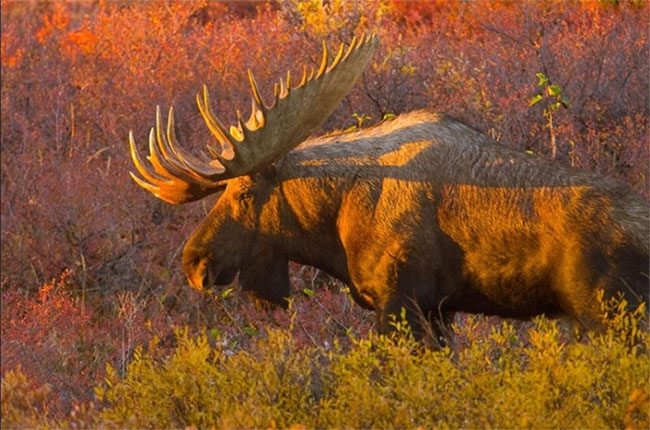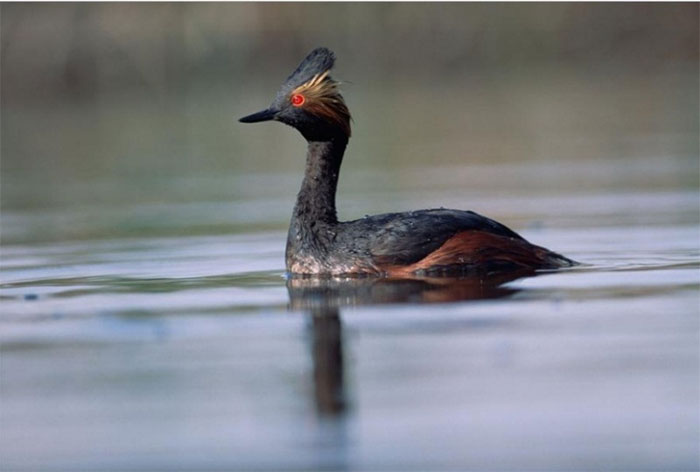The strange attraction of wildlife at autumn
It is autumn now, for people often this is the best season they want to enjoy and plan the holidays. On the contrary, for many animals, this is the season they are straining to prepare for the approaching winter.
The battle for mates of elk

An elk emerged from the bushes in the fall on the Alaskan tundra.(Photo: JOHN EASTCOTT and YVA MOMATIUK).
From September to October, deer species in the deer family are the mating season. Pictured is a full-fledged lonely elk ready to fight with the other males for the female. It is a wild animal living in the north of the United States, Canada, Alaska and Northern Europe.
The increase in testosterone caused the soft skin covering the elk antlers to peel off, turning into sharp weapons in battle.
A nearly 40-year study in Alaska's Denali National Park found that these winning males were often the largest and highest-ranking males, responsible for 88% of the mating. the. The female gives birth to the young deer in the spring, usually beginning in late May.
Autumn - the 'dressing' season of many birds

A new black-necked foul-tailed furry swims in a pool in New Mexico.(Photo: TIM FITZHARRIS).
While birds fly south to winter, there are a number of species that abandon their journey and stop on their way in the fall.
After leaving the Pacific Northwest and the Midwestern United States, black-necked leeches have found large quantities of food and 'shed' at Lake Mono in California and Great Salt Lake in Utah. Other species resting in the middle include Franklin's albatross stopping on the North American Plains, North American ducks stopping on the Great Lake, the brown back and other wading birds stopping on various beaches.
Every year, brown-backed birds move from the North Pole to the Southern Hemisphere and then return. They will fly for about 1,500 miles and then stop to rest, eat, and shed their hair faithfully in these places at the same time each year.
Resilient bears

A grizzly bear gobbles on a freshly caught salmon in Canada's Yukon.(Photo: PETER MATHER).
In the fall, the North American bears suddenly suffer from 'cravings' and are busy eating and drinking as much as possible to gain weight for long hibernation.
While people will suffer serious health consequences from obesity and prolonged inactivity, a recent study in Communications Biology found that gray bears' genes were adjusted differently in the fall. and winter to cope with the change in life.
For example, during hibernation, gray bears' genes decreased their sensitivity to insulin, so their blood sugar levels remained normal and that sugar was used for the brain during long sleeps.
This also allows large mammals to metabolize fat during hibernation, a function that human sleep cannot do, says Joanna Kelley, co-author of the study, an evolutionary geneticist at Washington State University said.
Ladybug eaters
Entomologist at the University of Maryland, Mike Raupp, said there are about 5,000 species of ladybirds and many species of beetles such as multicolored Asian beetles are invading in North America. They will fatten up with thousands of aphids and molluscs every occasion in autumn. After this party, the insects will gather in a large mass, where they will enter a dormant state to wait for the long winter.
Ladybugs like to crawl in the crevices of rocky outcrops, but sometimes they congregate in masses to the human wing, looking like a beautifully carved surface, Raupp likened.
This ladybug is often overlooked by predators, but if a certain hungry animal discovers this ladybug without paying attention to its warning color, the insects may turn to it. Fluid reflexes. The strong smell of stink bugs will disappoint poachers, Mr. Raupp said.
Birds 'hibernating'
While other birds are busy flying south to avoid cold weather in winter, common mosquito owls in western North America and Mexico remain.
These nocturnal members belong to the owl family, which is the only bird known to fall into a state similar to hibernation, when their body temperature can drop.

A mosquito owl immerses itself into its surroundings in British Columbia, Canada. ( Photo: JARED HOBBS).
The way the birds hibernate is to nest on the ground, where they can disguise their dappled brown feathers, making them almost invisible. Like mammals, mosquito owls have the highest weight before they hibernate, said Mark Brigham, a biologist at the University of Regina in Saskatchewan.
In his study in Arizona, Mr. Brigham found that hibernating owls often face the southwest, so the afternoon sun helps to warm them up to supplement their metabolism. of body.
Brigham, who co-authored a study, published this year in Oecologia, found that mosquito owls slept an average of about five days, but an exceptionally sleepy bird slept for 45 days.
- Strange weather phenomenon: Part of the United States is paralyzed because of ice and snow in early autumn
- Splendid collection throughout the United States
- Autumn photos set of yellow carpet
- Mid-autumn festival of 8x, 9x childhood is rustic but beautiful and clear
- Autumn leaves
- Beams of photos: Sac autumn brilliantly all over the world
- A bunch of nostalgic images of the old Mid-Autumn Festival
- Hanoi autumn moments are beautiful
- When does autumn 2019 in the Northern Hemisphere start?
- Beautiful 'golden autumn' paintings in countries
- Where does the Mid-Autumn Festival come from?
- Customary to welcome the unique Mid-Autumn Festival around the world
 Animal 'suffering' after hibernation
Animal 'suffering' after hibernation Why do goats climb well?
Why do goats climb well? Scientists were surprised to see chimpanzees eating turtles
Scientists were surprised to see chimpanzees eating turtles Giant catfish died deadly due to drought in Thailand
Giant catfish died deadly due to drought in Thailand